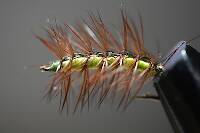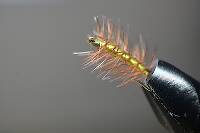
Hex Mayflies
Hexagenia limbata
The famous nocturnal Hex hatch of the Midwest (and a few other lucky locations) stirs to the surface mythically large brown trout that only touch streamers for the rest of the year.
Featured on the forum

This specimen appears to be of the same species as this one collected in the same spot two months earlier. The identification of both is tentative. This one suffered some physical damage before being photographed, too, so the colors aren't totally natural. I was mostly photographing it to test out some new camera setting idea, which worked really well for a couple of closeups.

Troutnut is a project started in 2003 by salmonid ecologist Jason "Troutnut" Neuswanger to help anglers and
fly tyers unabashedly embrace the entomological side of the sport. Learn more about Troutnut or
support the project for an enhanced experience here.
Dryfly on Aug 4, 2009August 4th, 2009, 3:46 pm EDT
The original EHC had the hackle tied in at the front of the fly, wrapped back and ribbed down with wire. I have tied it this way buy it always has a tendency to sink, presumedly because the wire makes it too heavy.
To combat this I tied the hackle at the bend dub the body and palmer forward. But then this incarnation of the EHC seems to unravel easier.
What way do you guys tie your EHC? Is there any really fine wire?
To combat this I tied the hackle at the bend dub the body and palmer forward. But then this incarnation of the EHC seems to unravel easier.
What way do you guys tie your EHC? Is there any really fine wire?
Softhackle on Aug 4, 2009August 4th, 2009, 4:23 pm EDT
Hi,
I don't palmer the body, but wrap the hackle at the front end of the hook as a collar, after tying in the wing. Another thing I do is tie in the wing by the tips rather than the butt ends, then trim and shape the wings with a sharp pair of scissors. It's a bit different than the standard Elk Hair Caddis, but it works.
Mark
I don't palmer the body, but wrap the hackle at the front end of the hook as a collar, after tying in the wing. Another thing I do is tie in the wing by the tips rather than the butt ends, then trim and shape the wings with a sharp pair of scissors. It's a bit different than the standard Elk Hair Caddis, but it works.
Mark
"I have the highest respect for the skilled wet-fly fisherman, as he has mastered an art of very great difficulty." Edward R. Hewitt
Flymphs, Soft-hackles and Spiders: http://www.troutnut.com/libstudio/FS&S/index.html
Flymphs, Soft-hackles and Spiders: http://www.troutnut.com/libstudio/FS&S/index.html
Martinlf on Aug 5, 2009August 5th, 2009, 9:01 am EDT
If you want a durable palmered hackle, one thing you can do is to use gel spun thread and leave a long tag at the bend when you wrap your thread, then tie in your hackle at the bend, dub forward, wrap your hackle forward, tie off, then spiral the tag thread forward through the hackle in the direction opposite to the way you wrapped the hackle. (i.e. if you palmered the hackle clockwise spiral the thread forward counterclockwise.) Wiggle the bobbin as you go to avoid trapping any hackles. Tie off the rib and then add the wing. There is very fine wire that can be used also. See Whitetail Flytying's catalog, for example, and order fine or extra fine wire. http://www.whitetailflytieing.com/
"He spread them a yard and a half. 'And every one that got away is this big.'"
--Fred Chappell
--Fred Chappell
Jmd123 on Aug 7, 2009August 7th, 2009, 11:45 am EDT
I do the hackle tied in near the front, palmer wrap back, and counterwrap forward with very fine wire, either silver (white/grey patterns)or gold (cream/tan/brown patterns). I have not had any problems with my elkhair caddis staying afloat. There is some very fine wire out there - ask your local fly shop. I think the wire adds a touch of both flash and segmentation to the body of the fly. An alternative is to leave a couple of inches of tag thread sticking out the back after your foundation wrap, and use this to counterwrap the the hackle - eliminating any extra weight. BTW, I also tie my woolly buggers this way, palmered back from the front with a wire counterwrap forward.
To each their own - so long as we're all catching fish!!
Jonathon
To each their own - so long as we're all catching fish!!
Jonathon
No matter how big the one you just caught is, there's always a bigger one out there somewhere...
Streamcaddi on Sep 4, 2009September 4th, 2009, 8:42 am EDT
I have started to use silver holographic tinsel for the body. I tie the rest of the fly as the pattern calls for. The fish love it.........
Sayfu
Posts: 560
Posts: 560
Sayfu on Nov 17, 2011November 17th, 2011, 11:05 am EST
I hackle forward with a smaller hackle not extending lower than the hook point, and do not rib. I want the fly to sit low in the water. Hackle binds into the dubbing, and I do not have much problem with the hackle breaking..can't remember when one did...but I do set the hook right in the side of the mouth with the fly extending outside the mouth. :)
Strmanglr on Nov 21, 2011November 21st, 2011, 7:37 am EST
Stop using wire, use tinsel.
Streamcaddi, I've been using pearl krystal flash, works great.
I tie in a piece of tinsel or krystal flash, tie in hackle feather, sometimes I dub, sometimes I don't, if I dub then I go down in hackle size. Dub forward, hackle forward, krystal flash forward opposite wrap.
I started doing something different with the elk hair in the last year and half. I do two loose wraps and tighten for the flare, one more wrap on top of flare. Then I pull back the front of the flare and place several wraps underneath, whip finish and cut the front flare. I found the several wraps underneath of the front flare holds the elk hair in place fine without a big pile of wraps over top of the elk hair. If it is at all loose a tiny bit of head cement on top of the wraps is fine, it's rare that it's needed though.
One of my favorite flies to fish, very visible and easy/quick tie.
Streamcaddi, I've been using pearl krystal flash, works great.
I tie in a piece of tinsel or krystal flash, tie in hackle feather, sometimes I dub, sometimes I don't, if I dub then I go down in hackle size. Dub forward, hackle forward, krystal flash forward opposite wrap.
I started doing something different with the elk hair in the last year and half. I do two loose wraps and tighten for the flare, one more wrap on top of flare. Then I pull back the front of the flare and place several wraps underneath, whip finish and cut the front flare. I found the several wraps underneath of the front flare holds the elk hair in place fine without a big pile of wraps over top of the elk hair. If it is at all loose a tiny bit of head cement on top of the wraps is fine, it's rare that it's needed though.
One of my favorite flies to fish, very visible and easy/quick tie.
Quick Reply
Related Discussions
Topic
Replies
Last Reply
Re: Three Trouble Makers at the Midwest Fly Fishing Expo the past weekend

In the Photography Board by Oldredbarn

In the Photography Board by Oldredbarn
3
Mar 11, 2014
by TNEAL
by TNEAL
1
Sep 21, 2008
by GONZO
by GONZO
6
Sep 11, 2020
by Martinlf
by Martinlf








